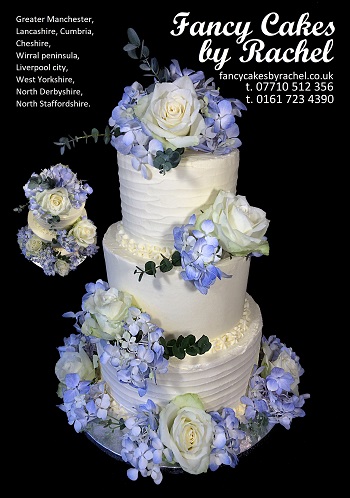The wedding cake has it's roots in several different traditions.
It is thought that the first wedding cakes were made in Ancient Greece, but little is know about the wedding cake tradition from this time.
In ancient Rome a cake of wheat or barley, basically a bread, was broken over the bride's head. This tradition was thought to bring good fortune to the couple.
A "bride's pie" was served at weddings in the 16th and 17th centuries.The bride's pie was savoury, unlike our sweet, modern wedding cake. The bride' pie was a pastry filled with various meats, oysters,and pine nuts and would have had live birds or even a snake inside it. All the wedding guests were expected to eat a piece of the pie and it was considered bad-mannered and bad-luck not to eat a piece of the pie.
A glass ring may also have been placed inside the pie and the person who found it would be the next to marry. This tradition can be seen in the present day catching of the bride's bouquet. Where the bride turns round, with her back to the wedding guests and throws the bouquet over her head. Whoever catches the bouquet will be the next to marry.
In the 17th century it was usual for there to be two cakes . The bride's cake and the groom's cake. The groom's cake was ususally smaller and a darker colour, made with fruits or chocolate, to symbolise masculinity. The bride's cake would be bigger and lighter in colour, usually a sponge cake.
In medieval England many small cakes were stacked up as high as possible and the birde and groom had to kiss over the top of the cake. If they managed this they woud have a successful marriage. This stacking up of small cakes is thought to be the origin of the croquembouche in France. The croquembouche is a pile of profiteroles stacked up in a conical shape and held together with spun sugar or caramel. These are popular in France and increasingly so un the UK.
By the 18th century the wedding cake became a symbol of prosperity. Made with fruit and covered with marzipan and icing which were expensive at the time.
In the victorian era white sugar was expensive and only the well-off coulld afford it. White icing on the cake signified wealth and social status. White icing became known as royal icing after Queen Victoria's wedding cake was iced with ure white icing.
There is much symbolim surrounding the wedding cake. Wedding cakes have been used in wedding ceremonies for centuries and have changed in ingredients and form over time.
The chinese serve a tiered cake from the bottom tier first. The first pieces are given to the couple's parents and other older relatives to honour them as the foundation of the family.
In the USA ribbons are attached to the bottom tier of the cake and female guests would pull them out . One ribbon would have a charm, usually a ring, attached to it and the person who pulled the ribbon with the charm would be the next to marry.
In some traditions the wedding cake is broken over the bride's head to give the couple good fortune and fertility.
In the past, unmarried female wedding guests may take a slice of wedding cake home and sleep with it under their pillow in the hope of finding a husband.
Most of these traditions are now outdated and no longer relevant to today's society. But the wedding cake is still and important part of the wedding tradition.
And couples choose their wedding cake design to reflect who they are: big and bold, elegant, rustic, fun, small and beautiful. They choose cake flavours they like not what is regarded as tradition.

